Implementation of Reverse Proxy in Node js
 Sanskar Gupta
Sanskar Gupta
A reverse proxy is a server that sits between client machines and backend servers. When a client makes a request to a reverse proxy, the reverse proxy forwards the request to the appropriate backend server. The response from the backend server is then sent back to the client by the reverse proxy. Here are several reasons why reverse proxies are commonly used:
Load Balancing: One of the primary reasons for using a reverse proxy is to distribute incoming requests across multiple backend servers. This helps to evenly distribute the workload among servers, improving overall performance, scalability, and reliability.
Security: Reverse proxies can provide an additional layer of security by hiding the details of backend servers from external clients. They can also perform tasks such as SSL termination, filtering requests based on security policies, and protecting against various types of attacks such as DDoS attacks.
Caching: Reverse proxies can cache static content or frequently accessed dynamic content, reducing the load on backend servers and improving response times for clients. This is especially useful for websites and applications that serve a large number of users.
SSL Offloading: Reverse proxies can handle SSL/TLS encryption and decryption, relieving backend servers from the computational overhead associated with these tasks. This can improve the performance of backend servers, especially in scenarios with high volumes of encrypted traffic.
Content Compression: Reverse proxies can compress content before sending it to clients, reducing bandwidth usage and improving load times, particularly for clients with limited bandwidth or slower internet connections.
URL Rewriting: Reverse proxies can rewrite URLs, allowing for more flexible routing and mapping of incoming requests to specific backend servers or resources.
Centralized Logging and Monitoring: By routing all incoming and outgoing traffic through a reverse proxy, it becomes easier to monitor and log requests, track performance metrics, and analyze traffic patterns. This centralized logging and monitoring can be valuable for troubleshooting, performance optimization, and security auditing.
Subscribe to my newsletter
Read articles from Sanskar Gupta directly inside your inbox. Subscribe to the newsletter, and don't miss out.
Written by

Sanskar Gupta
Sanskar Gupta
Backend Developer in Node.Js (exploring new tech )